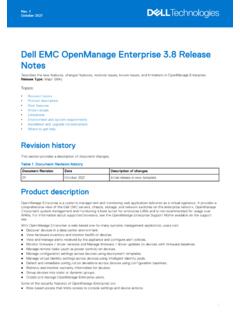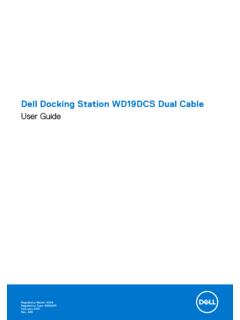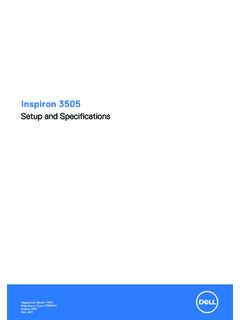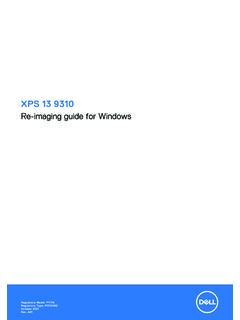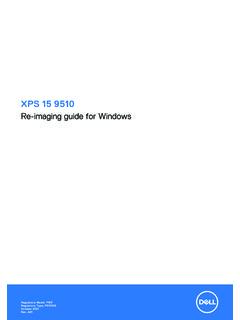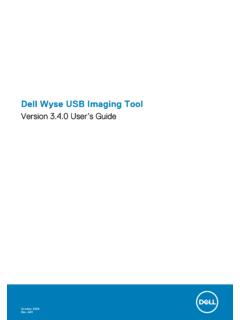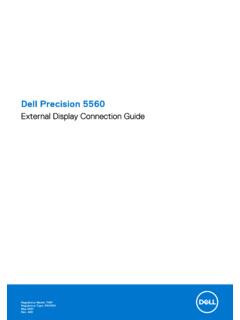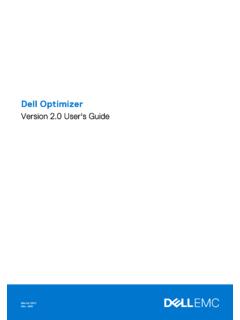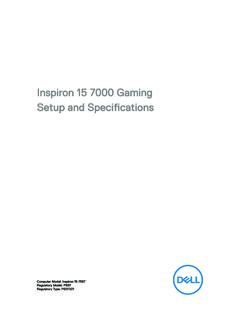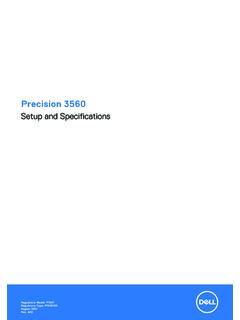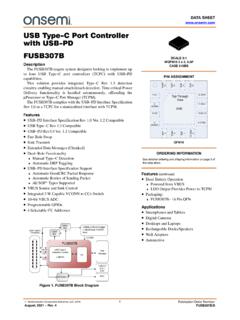Transcription of Inspiron 15 5000 Setup and Specifications - Dell
1 Inspiron 15 5000. Setup and Specifications Computer Model: Inspiron 5570. Regulatory Model: P75F. Regulatory Type: P75F001. Notes, cautions, and warnings NOTE: A NOTE indicates important information that helps you make better use of your product. CAUTION: A CAUTION indicates either potential damage to hardware or loss of data and tells you how to avoid the problem. WARNING: A WARNING indicates a potential for property damage, personal injury, or death. 2017-2018 Dell Inc. or its subsidiaries. All rights reserved. Dell, EMC, and other trademarks are trademarks of Dell Inc. or its subsidiaries. Other trademarks may be trademarks of their respective owners. 2018 - 10. Rev. A03. Contents Set up your 5. Create a USB recovery drive for Reinstall Windows using a USB recovery 9. 10. For computers with optical For computers without optical 11.
2 11. 14. Computer 14. System 14. Operating Dimensions and 15. 15. Intel Optane memory (optional).. 16. ports and 3. Wireless 17. 18. Media-card 20. Touchpad 20. Power Computer Keyboard 24. Getting help and contacting Self-help 27. Contacting 4. Set up your computer 1 Connect the power adapter and press the power button. NOTE: To conserve battery power, the battery might enter power saving mode. Connect the power adapter and press the power button to turn on the computer. 2 Finish operating system Setup . For Ubuntu: Follow the on-screen instructions to complete the Setup . For Windows: Follow the on-screen instructions to complete the Setup . When setting up, Dell recommends that you: Connect to a network for Windows updates. NOTE: If connecting to a secured wireless network, enter the password for the wireless network access when prompted.
3 If connected to the internet, sign-in with or create a Microsoft account. If not connected to the internet, create an offline account. On the Support and Protection screen, enter your contact details. 5. 3 Locate and use Dell apps from the Windows Start menu Recommended Table 1. Locate Dell apps Dell Product Registration Register your computer with Dell. Dell Help & Support Access help and support for your computer. SupportAssist Proactively checks the health of your computer's hardware and software. NOTE: Renew or upgrade your warranty by clicking the warranty expiry date in SupportAssist. Dell Update Updates your computer with critical fixes and important device drivers as they become available. Dell Digital Delivery Download software applications including software that is purchased but not pre-installed on your computer.
4 4 Create recovery drive for Windows. NOTE: It is recommended to create a recovery drive to troubleshoot and fix problems that may occur with Windows. For more information, see Create a USB recovery drive for Windows. 6. Create a USB recovery drive for Windows Create a recovery drive to troubleshoot and fix problems that may occur with Windows. An empty USB flash drive with a minimum capacity of 16 GB is required to create the recovery drive. NOTE: This process may take up to an hour to complete. NOTE: The following steps may vary depending on the version of Windows installed. Refer to the Microsoft support site for latest instructions. 1 Connect the USB flash drive to your computer. 2 In Windows search, type Recovery. 3 In the search results, click Create a recovery drive. The User Account Control window is displayed.
5 4 Click Yes to continue. The Recovery Drive window is displayed. 5 Select Back up system files to the recovery drive and click Next. 6 Select the USB flash drive and click Next. A message appears, indicating that all data in the USB flash drive will be deleted. 7 Click Create. 8 Click Finish. For more information about reinstalling Windows using the USB recovery drive, see the Troubleshooting section of your product's Service Manual at Reinstall Windows using a USB recovery drive CAUTION: This process formats the hard drive and removes all data on your computer. Ensure that you back up data on your computer before beginning this task. NOTE: Before reinstalling Windows, ensure your computer has more than 2. GB of memory and more than 32 GB of storage space. 7. NOTE: This process may take up to an hour to complete and your computer will restart during the recovery process.
6 1 Connect the USB recovery drive to your computer. 2 Restart your computer. 3 Press F12 after the Dell logo is displayed on the screen to access the boot menu. A Preparing one-time boot menu message appears. 4 After the boot menu loads, select the USB recovery device under UEFI BOOT. The system reboots and a screen to Choose the keyboard layout is displayed. 5 Choose your keyboard layout. 6 In the Choose an option screen, click Troubleshoot. 7 Click Recover from a drive. 8 Choose one of the following options: Just remove my files to do a quick format. Fully clean the drive to do a complete format. 9 Click Recover to start the recovery process. 8. Views Left 1 Power-adapter port Connect a power adapter to provide power to your computer and charge the battery. 2 Battery-status light/hard-drive activity light Indicates the battery-charge status or the hard-drive activity.
7 NOTE: Press Fn+H to toggle between the battery-status light and hard-drive activity light. Hard-drive activity light Turns on when the computer reads from or writes to the hard drive. NOTE: Hard-drive activity light is supported only on computers shipped with hard drive. Battery-status light Indicates the battery-charge status. Solid white: Power adapter is connected and the battery has more than 5%. charge. Amber: Computer is running on battery and the battery has less than 5%. charge. Off: Power adapter is connected and the battery is fully charged. Computer is running on battery and the battery has more than 5% charge. Computer is in sleep state, hibernation, or turned off. 3 USB Gen 1 (Type-C) port with Power Delivery/DisplayPort (optional). 9. Connect peripherals such as external storage devices, printers, and external displays.
8 Supports Power Delivery that enables two-way power supply between devices. Provides up to 15 W power output that enables faster charging . NOTE: An adapter (sold separately) is required to connect a DisplayPort device. 4 HDMI port Connect to a TV or another HDMI-in enabled device. Provides video and audio output. 5 Network port Connect an Ethernet (RJ45) cable from a router or a broadband modem for network or Internet access. 6 USB Gen 1 ports (2). Connect peripherals such as external storage devices and printers. Provides data transfer speeds up to 5 Gbps. 7 Headset port Connect headphones or a headset (headphone and microphone combo). Right For computers with optical drive 1 SD-card slot Reads from and writes to the SD card. 2 USB port Connect peripherals such as external storage devices and printers. Provides data transfer speeds up to 480 Mbps.
9 3 Optical drive Reads from and writes to CDs, DVDs, and Blu-ray discs. 10. NOTE: Blu-ray support is only available in certain regions. 4 Security-cable slot (for Noble locks). Connect a security cable to prevent unauthorized movement of your computer. For computers without optical drive 1 SD-card slot Reads from and writes to the SD card. 2 USB port Connect peripherals such as external storage devices and printers. Provides data transfer speeds up to 480 Mbps. 3 Security-cable slot (for Noble locks). Connect a security cable to prevent unauthorized movement of your computer. Display 11. 1 Left microphone Provides digital sound input for audio recording and voice calls. 2 Camera Enables you to video chat, capture photos, and record videos. 3 Camera-status light Turns on when the camera is in use. 4 Right microphone Provides digital sound input for audio recording and voice calls.
10 Base 1 Left-click area Press to left-click. 2 Touchpad Move your finger on the touchpad to move the mouse pointer. Tap to left-click and two finger tap to right-click. 3 Right-click area Press to right-click. 4 Power button with optional fingerprint reader 12. Press to turn on the computer if it is turned off, in sleep state, or in hibernate state. When the computer is turned on, press the power button to put the computer into sleep state; press and hold the power button for 4 seconds to force shut- down the computer. If the power button has a fingerprint reader, place your finger on the power button to log in. NOTE: You can customize power-button behavior in Windows. For more information, see Me and My Dell at manuals. Bottom 1 Left speaker Provides audio output. 2 Service Tag label The Service Tag is a unique alphanumeric identifier that enables Dell service technicians to identify the hardware components in your computer and access warranty information.
